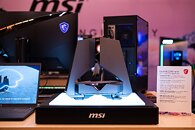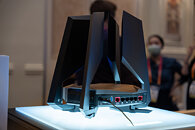TheLostSwede
News Editor
- Joined
- Nov 11, 2004
- Messages
- 18,475 (2.47/day)
- Location
- Sweden
| System Name | Overlord Mk MLI |
|---|---|
| Processor | AMD Ryzen 7 7800X3D |
| Motherboard | Gigabyte X670E Aorus Master |
| Cooling | Noctua NH-D15 SE with offsets |
| Memory | 32GB Team T-Create Expert DDR5 6000 MHz @ CL30-34-34-68 |
| Video Card(s) | Gainward GeForce RTX 4080 Phantom GS |
| Storage | 1TB Solidigm P44 Pro, 2 TB Corsair MP600 Pro, 2TB Kingston KC3000 |
| Display(s) | Acer XV272K LVbmiipruzx 4K@160Hz |
| Case | Fractal Design Torrent Compact |
| Audio Device(s) | Corsair Virtuoso SE |
| Power Supply | be quiet! Pure Power 12 M 850 W |
| Mouse | Logitech G502 Lightspeed |
| Keyboard | Corsair K70 Max |
| Software | Windows 10 Pro |
| Benchmark Scores | https://valid.x86.fr/yfsd9w |
If you're looking at upgrading to WiFi 7, but don't want a router that looks like a dead bug, then maybe MSI has the router for you, with its upcoming RadiX BE22000 Turbo router. The BE22000 part in the name refers to 802.11be which is the IEEE naming for WiFi 7 and the max theoretical throughput of the router, i.e. 22 Gbps combined across all bands. The RadiX BE22000 Turbo supports 320 MHz channel width, or twice that of WiFi 6 and it's the main reason why WiFi 7 can be so much faster than WiFi 6.
Other features include AI QoS which MSI claims automatically prioritises gaming packets over other types of data packets being sent by the router and it can be configured via a companion app. The RadiX BE22000 Turbo also supports MLO or Multi-Link Operation, which enables supported clients to connect to the router using more than one frequency band for increased throughput. MSI didn't reveal much when it comes to the hardware features of the router, but it does have a pair of 10 Gbps ports, as well as four 2.5 Gbps, making it a better choice than ASUS' recently announced RT-BE96U, which only has Gigabit ports in addition to its two 10 Gbps ports.


View at TechPowerUp Main Site | Source
Other features include AI QoS which MSI claims automatically prioritises gaming packets over other types of data packets being sent by the router and it can be configured via a companion app. The RadiX BE22000 Turbo also supports MLO or Multi-Link Operation, which enables supported clients to connect to the router using more than one frequency band for increased throughput. MSI didn't reveal much when it comes to the hardware features of the router, but it does have a pair of 10 Gbps ports, as well as four 2.5 Gbps, making it a better choice than ASUS' recently announced RT-BE96U, which only has Gigabit ports in addition to its two 10 Gbps ports.


View at TechPowerUp Main Site | Source











